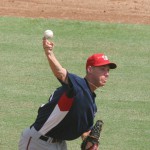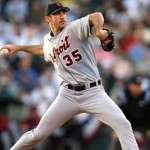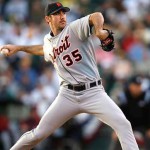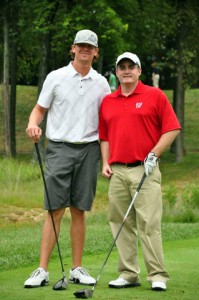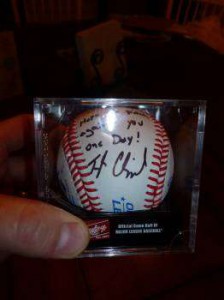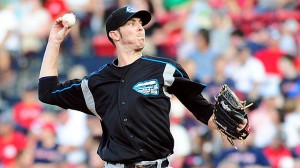Standard disclaimer; I do this post every year. If you don’t play fantasy, you probably won’t care about the 3,000 words contained herein.
Because of the sheer number of players discussed, i’ll eschew my normal bolding of all names except those picked for my team so this post is more readable.
My annual Fantasy Baseball draft was held this week. Here’s a re-cap of my team and my drafting strategy.
I had the 4th pick in a 12-team snake draft. 6×6 head-to-head league (the extra categories are OPS on the hitting side and Losses on the pitching side). I obtained the 4th pick through a new draft order selection wrinkle introduced this year; instead of our typical double blind method of picking the order, we each submitted our choice of which pick we wanted. I selected the 4th pick, thinking that Kershaw would be available here (or if he wasn’t, then i’d get one of the top 3 hitters who had slipped). I won a coin-toss and kept the 4th pick.
Strategy: I wanted to be strong in Starting Pitching. I wanted at least two top-notch closers. I did not want to over-book OF positions early. I would wait for 1B and the middle infield positions.
At the end of the day, here was my team, in order of round selected:
- Clayton Kershaw, LAD
- Stephen Strasburg, Wsh
- Michael Brantley, Cle
- Corey Dickerson, Col
- Aroldis Chapman, Cin
- Matt Harvey, NYM
- Christian Yelich, Mia
- Brian Dozier, Min
- Chris Carter, Hou
- Joaquin Benoit, SD
- Evan Gattis, Hou
- Michael Wacha, StL
- Santiago Casilla, SF
- Phil Hughes, Min
- Lucas Duda, NYM
- Shelby Miller, Atl * (see below)
- Taijuan Walker, Sea
- Jhonny Peralta, StL
- Adam LaRoche, CWS
- Nick Castellanos, Det
- Brandon McCarthy, LAD
Round by Round thinking
(the notation will be Xth overall pick in our draft, and then the Yahoo o-rank and 2014 rank, and then blended average ADP of the guy selected. the Yahoo “o-rank” is Yahoo’s 2015 projected ranking).
- Round 1 (4th overall pick, O-rank of #5, 2014 rank of #1, Blended ADP of #3) I had the 4th pick; the first three picks were Trout, Stanton, McCutchen. So my choice was either Kershaw or Goldschmidt? I had targeted Kershaw by asking for the 4th pick, there’s lots of 1b depth, so going going with my SP. I targeted Kershaw simply because, despite his ADP and o-ranks, he was the #1 fantasy player last year despite missing a month of starts, and I see no reason why he shouldn’t pick right back up. I feel like i’m getting great value at #4 by grabbing the #1 overall player. The pick: Clayton Kershaw. I’ll say this: I fully believe that Max Scherzer will have a massive year and may very well be a better fantasy player than Kershaw in 2015 … but at the #4 pick, the odds of getting Scherzer to return to me were beyond nil. I could have gambled on a lower pick in the draft and taken Scherzer later (his blended ADP rank is #16), but there are a couple of “unique” teams in the league who draft home-town heavy. Sure enough, Scherzer went like 3 picks later, a pretty big overdraft.
- Round 2 (21st, 22nd, 48th in 2014, 23rd ADP): I really wanted Josh Donaldson here, and he went the pick before me. Which left me with a problem. Beltre, Freeman, Brantley all avail… don’t like any of them at this spot. Rendon was best ADP but as we all know he’s looking more and more like he’s missing half the season. After Rendon in ADP was Bumgarner and Sale; don’t really like either of those guys at this spot. To heck with it: I picked Stephen Strasburg. I really, really didn’t want to have two SPs at this point, and I promise I was not emulating some sort of pitcher heavy strategy. If it hadn’t been for Rendon’s injury, I would have taken him there and been very happy. From a value perspective, outside of Straburg’s somewhat disappointing 2014 rank this pick was right in line with Yahoo and ADP.
- Round 3 (28th, 20th, 6th in 2014, 26th ADP) I wanted Harper here, badly. Literally, as I was thinking “Harper” he got picked, 2 spots before me. My choices then were the likes of Freeman, Posey, Price, Brantley. I don’t like Freddie Freeman this year; who would bother to pitch to him? Posey is always hurt, and I just couldn’t take a 3rd pitcher in a row. So I took Michael Brantley. Ironically, Brantley was under consideration for my 2nd round pick and was still available 7 picks later. This is always a good sign. Why did he drop to 26th in ADP despite being #6 in Yahoo last year? Maybe it was a career, unrepeatable year, but he’s not going to bottom out. 20/20 guy, great average, great OPS and plays in a hitter’s park. I think this could be a great pick.
- Round 4: (45th, 40th, 39th in 2014, 42nd in ADP) Needing more hitters, I was looking basically at Dickerson and Marte here. ADP has Lester, Reyes; I don’t trust Lester going to the bandbox in Wrigley, and I can’t stand Reyes in fantasy (always, always hurt). So I grabbed Corey Dickerson. Dickerson had great power numbers in the minors, and had 24 homers in just 436 ABs last year. Plays in Colorado, his slash line is great. I feel like he’s going to be a top 25 fantasy producer in 2015.
- Round 5 (52nd overall pick, 55th ranked, 93rd in 2014, 46th in ADP): a strategy play; last year I got my two main closers in the 5th and 6th rounds and rode them all year. Knowing that i’d not be picking again for 17 picks … and after my hopeful “sleeper” pick Pujols got nabbed right after my 4th round pick, I looked at the board, didn’t like what I saw (Longoria, v-Mart, Hamels, Car-Go; injury, injury, Phillies and injury concern) and grabbed the best closer out there. Aroldis Chapman. Yes Kimbrel might be “better,” but Kimbrel is pitching for a team that will struggle to 65 wins. He’s just not going to get the save opportunities that Chapman will. Chapman’s 2014 rank took a tumble with his injury; he should continue his ridiculous K/9 rate and get plenty of saves for Cincinnati.
- Round 6: (69th overall pick, 44th ranked, did not play in 2014, 57th ADP). For the entirety of the 6th round, I was hoping for Harvey. He lasted, he lasted … and I got him at 69th overall pick. Matt Harvey. Perhaps an overdraft based on who he is and what he’s coming back from. However, at the time of this pick he was top available player on my ADP list. Debate in the room ensued; is he on an innings limit? Is he ready to come back? My answers are this: Harvey, when healthy, was a ridiculous combination of awesome. Here’s some 2013 stats: in just 26 starts he racked up 6.5 wins on Fangraphs. His FIP and xFIP numbers showed that he was due for *improvement*. And perhaps the most amazing stat to me: he was 3rd in the league in K/BB ratio despite leading the league in fastball velocity (for starters). In other words, he threw the hardest *and* had nearly the best control in the league. Sign me up. I think I may have just gotten a top-5 starting pitcher at the end of the 6th round.
- Round 7 (76th overall pick, 77th ranked, 33rd in 2014, 60th ADP). Ok, at this point I’m in somewhat of a roster pickle. I have four pitchers and just two batters and face a big gap before picking again. I targeted best hitters available: I wanted someone like Fielder, Davis (gone, gone). I targeted Kyle Seager: he went 2 before me. So I looked at the 2B available (there were a ton at this stage on the board) and Brian Dozier was the pick. 20/20 guy, average not great, but 33rd ranked in 2014 so undervalued here. I got him basically a round later than he should have gone by ADP. Good value, and I have a decent 2B (which I struggled with last year).
- Round 8: (93rd pick, 72nd ranked, 76th in 2014, 80 ADP). Another big gap in the drafting; lots of guys off the board. Is it too early for Kris Bryant? I really, really want Bryant. But … he went 3 picks before me. d*mn. I was left with very little to choose from; ended up taking Christian Yelich. Not the sexiest pick; he was good for me last year. Lots of steals, not a ton of power.
- Round 9: (100th pick, 108th ranked, 94th in 2014, 118th ADP). Now what? another reliever? Too early for a reliever. There were good starters on the board (like Arrieta and Teheran). But I need bats now. This is the problem with drafting too many starters early; there’s a ton of value these days later on (as we’ll see with some of my later picks). So I grabbed best hitter on ESPN’s board and the best position player that didn’t duplicate what I already had (OFs): went with Chris Carter. Huge bat; 37 homers last year. Awful average. How does he only score 68 runs when 37 of them were his own homers? You have to think some of these numbers will improve as Houston improves. He should have more RBIs with better hitters getting on base ahead of him.
- Round 10: (117th overall, 145 o-rank, 141st in 2014, 164 ADP). In the 17 picks after I thought about doing a closer … there was a huge run on them. Literally 8 of the 17 picks between my 9th and 10th round were closers. I was hoping that some one like Cishek held out but was disappointed? I took Joaquin Benoit. I figure that any pitcher in San Diego is 15% better just because of the stadium, and figure that SD will be better this year and Benoit will get saves.
- Round 11: (124th overall, 110 o-rank, 289 2014 rank, 84th ADP). As with Bryant, I was starting to look at uber-rookie Pederson as a sleeper … and he went way, way early. I also really liked Pablo Sandoval here .. and he got picked just before me. Damn. Evan Gattis is C eligible … best hitter available at this point and he fills my troublesome C slot. Got him. Gattis hit 22 homers in just 369 ABs last year, and he’ll be a DH/corner OF in a better hitter’s park. So he should stay healthy. Healthier that is. He should immediately get OF eligibility too.
- Round 12: (141 overall, 138 o-rank, 232 in 2014, 132 ADP) Was looking at Garrett Richards … but he’s hurt and won’t be back til end of april. No more decent RPs right now. Can wait for later on. I went with best starter avail; Michael Wacha. This isn’t without concern here; a “stress fracture” in his throwing shoulder cost him half of last year. I don’t forget though just how dominant he was in the 2nd half of 2013; we’ll hope he returns to that form.
- Round 13: (148 overall, 171 o-rank, 149 in 2014, 193 ADP). I need a hitter; there are still 1Bs available, and plenty of them. But I don’t like what’s here at this point for this pick; I can wait. So I got the best remaining closer on the market: Santiago Casilla. And by “best” i mean, closer for the best remaining team. You don’t want to invest in a closer of a last place team, or a team with a bullpen by committee approach. Casilla might get supplanted by Romo (and in fact someone picked up my closer “handcuff” later on). We’ll keep an eye out.
- Round 14/15: (From here out, instead of going round by round, I’ll talk about the pairs of picks since they’re so close together). I still need SS and 3B. I still don’t like what’s out there for either and and think they can hold on. So the goal was to get another good hitter plus a good SP. I ended up with Phil Hughes (165th overall, 122nd o-rank, 102 in 2014, 133rd in ADP) and Lucas Duda (172nd overall, 143 o-rank, 72nd in 2014, 155th ADP). I like both of these picks for value: Hughes was great in 2014, came out of nowhere pitching in a big park. By his 2014 numbers he went at least 5 rounds later than value. Meanwhile I had been looking at Duda for a while; had him last year, he’s a masher. 30 homers in 2014 while being platooned a little bit. He always scares me when he bats against the Nats.
- Round 16/17: At this point, I *still* don’t have a SS or 3B. Except that, once again, looking at the board and who is available, I know I could wait on both and still get someone as decent in two rounds from now as if I drafted them now. So instead, I’m looking at pitchers. There’s no reason to take an experimental closer at this point, so I’m getting the two best SPs on the market. I got Shelby Miller (189th overall, 228th o-rank, 323 2014 rank, 243 ADP) and Taijuan Walker (196th overall, 202 o-rank, 417 ranked last year, 223 ADP). Both are overdrafts by nearly all measures, but both are interesting plays. All i’ve been reading about Walker this spring is how awesome he’s looked, how un-hittable he’s been. And he pitches in the pitcher-friendly confines of Seattle. Miller is more of a riskier pick; he’s moved teams, is now pitching for the woeful Braves … but i’ve always liked him and have had him every year he’s been a pro. There is a caveat to the Miller pick; apparently the guy who picked right before me asked me about Miller’s availability, and I either neglected to answer or misled him … so he picked Jose Quintana. When I picked Miller immediately after him, he cried foul. I promise I wasn’t trying to mis-lead him, and will immediately offer Miller in trade for Quintana as soon as the rosters are available. So instead of Miller, I may have Quintana.
- Round 18-21: by this point it was past 11:30pm and we were pretty beat. I had been targeting two specific SS/3B players for several rounds, knowing they probably wouldn’t get picked. So I grabbed them, the best hitter remaining, plus one last SP to finish off the draft. My last four picks were:
- Jhonny Peralta (213 overall pick, 193 o-rank, 150th last year, 198th ADP): 20 homers last year, serviceable BA and OPS. Best SS left.
- Adam LaRoche (220th pick, 126 o-rank, 79th last year, 153 ADP): I love grabbing guys like LaRoche; because he plays a busy position, and despite his production last year (79th best fantasy player should have put him in the 7th round), he drops to almost waiver-wire levels. I’ll take that for the 19th round; 79th best player last year with the 220nd pick.
- Nick Castellanos (237th pick, 267 o-rank, 303rd last year, 300+ in ADP). Might be a wasted pick; of the 3B left, he sounded the most intriguing. But 300+ in ADP, he wasn’t even on my draft list. I’m pretty sure that the likes of Prado, Headley and even *gasp* Alex Rodriguez are 3B eligible and on waivers; we may make an early waiver wire move.
- Brandon McCarthy (244th pick, 170 o-rank, 332 last year, 236 ADP): last pick, and I got what I think will be a pretty serviceable starter. McCarthy’s numbers were awesome for the Yankees last year once he escaped the sh*tty situation in Arizona. Now he goes to LA, where he’s probably the 3rd starter for the 2nd best team in the NL. This could be a seriously good pick.
So, here’s the team by positions:
- C: Gattis
- 1B: Carter, Duda, LaRoche
- 2B: Dozier
- SS: Peralta
- 3B: Castellanos
- OF: Brantley, Dickerson, Yelich
- SP: Kershaw, Strasburg, Harvey, Wacha, Hughes, Miller/Quintana, McCarthy
- RP: Chapman, Benoit, Casilla
Initial glance: I can’t remember the last time I had starting pitching anywhere near this good. Incredibly weak at 2B/SS/3B. Not the greatest set of hitters in general. Relievers have one great, one good, one crap-shoot; i’ll have to play the waiver wire game to try to grab an extra.
Here’s a breakdown of the 2014 stats for my hitters:
| H/AB | R | HR | RBI | SB | AVG | OPS | |
| Gattis | 97/369 | 41 | 22 | 52 | 0 | 0.263 | 0.81 |
| Carter | 115/507 | 68 | 37 | 88 | 5 | 0.227 | 0.799 |
| Duda | 130/514 | 74 | 30 | 92 | 3 | 0.253 | 0.83 |
| LaRoche | 128/494 | 73 | 26 | 92 | 3 | 0.259 | 0.817 |
| Dozier | 145/598 | 112 | 23 | 71 | 21 | 0.242 | 0.761 |
| Peralta | 147/560 | 61 | 21 | 75 | 3 | 0.263 | 0.779 |
| Castellanos | 138/533 | 50 | 11 | 66 | 2 | 0.259 | 0.7 |
| Brantley | 200/611 | 94 | 20 | 97 | 23 | 0.327 | 0.891 |
| Dickerson | 136/436 | 74 | 24 | 76 | 8 | 0.312 | 0.931 |
| Yelich | 165/582 | 94 | 9 | 54 | 21 | 0.284 | 0.764 |
So, nearly every guy was a 20+ homer guy; lots of power on this team. Three 20+ SB guys; that’s a good sign. The averages aren’t great; that’s just a blended average of about .270. My blended OPS is about .808. By way of comparison, the MLB average last year was .253 for BA and .714 in OPS. I can’t remember what the fantasy averages were, but i’m guessing these are going to be low. A surprising number of decent RBI guys here; three that were near 100 RBIs last year. Another three guys who were near or over 100 runs. So maybe this team won’t be that bad on the offensive side.
Let the games begin!





